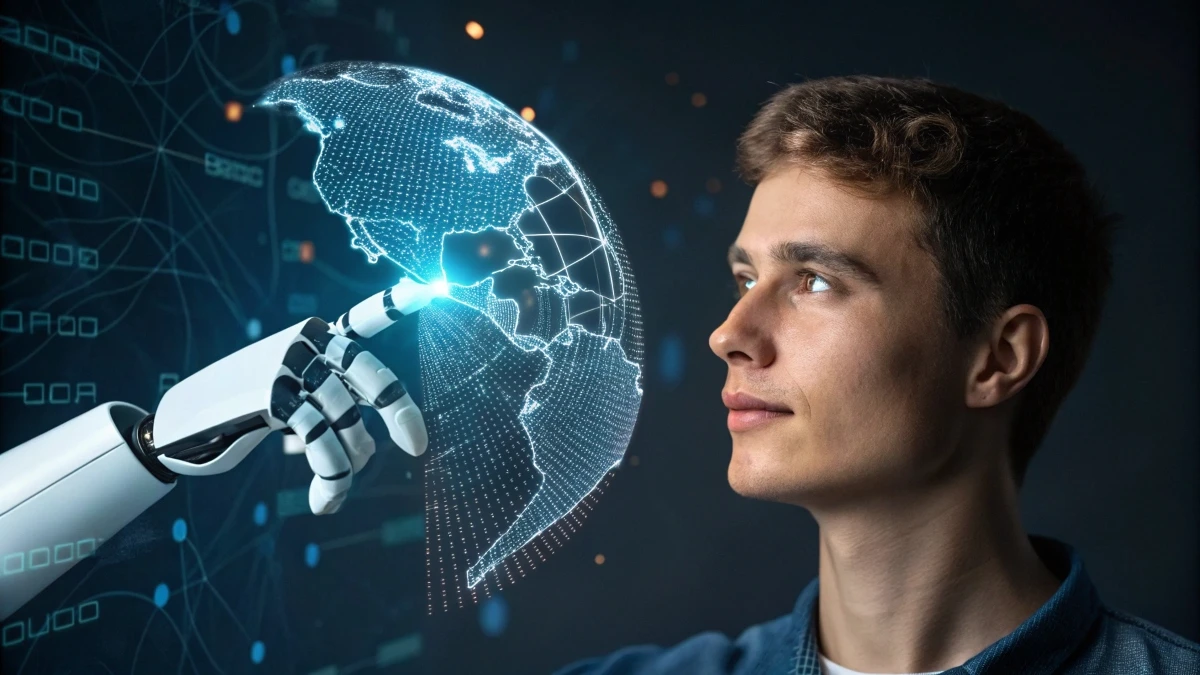Will AI Steal Your Job? Why Experts Say Universal Basic Income is Inevitable by 2025 – Prepare Now!

Your next job interview might be with an AI, not a human. Right now, smart machines analyze resumes, handle customer service, and make business decisions faster than any person could.
The numbers tell a clear story: companies are switching to AI at record speed, and traditional jobs are changing fast. But here’s the good news.
Experts point to Universal Basic Income as a real solution coming by 2025. This shift means everyone could get steady financial support while they adapt to new work opportunities.
The future of work looks different, but it’s not about losing jobs it’s about transforming how we earn and live. This guide shows you exactly what’s happening and how to stay ahead of these changes.
The Current State of AI and Employment

The integration of artificial intelligence in workplaces has accelerated beyond predictions, with a significant shift in how businesses operate and make decisions. Machine learning algorithms now handle tasks that once required human judgment, from medical diagnoses to financial trading. Recent data from the International Labor Organization shows that 85 million jobs globally might be displaced by AI by 2025.
Manufacturing has seen the most dramatic transformation, with AI-powered robots working alongside humans in smart factories. These systems use computer vision and natural language processing to control quality, manage inventory, and coordinate production schedules. The automotive industry leads this change, with companies reporting a 30% increase in production efficiency after implementing AI systems.
The service sector faces similar changes through automated customer service platforms and AI-driven analytics. Banks now process loan applications using AI algorithms that assess risk factors and make decisions in minutes. Healthcare organizations use AI to analyze medical images and patient data, leading to faster and more accurate diagnoses. This shift has created a complex employment landscape where traditional roles evolve or disappear while new positions emerge.
Job Markets in Transition

The transformation of job markets shows clear patterns across different sectors. Administrative work faces the highest risk of automation, with AI systems capable of managing schedules, processing documents, and handling routine correspondence. Data entry positions, once abundant, now face rapid decline as natural language processing and optical character recognition technologies improve.
Middle-management roles are changing fundamentally. AI systems now handle many analytical and decision-making tasks, from resource allocation to performance monitoring. This shift requires managers to develop new AI system oversight and strategic planning skills. According to recent studies by MIT Technology Review, jobs requiring repetitive cognitive tasks have decreased by 42% in organizations that implemented advanced AI systems.
The geographic impact varies significantly. Urban centers with high concentrations of technology companies show faster adoption rates of AI technologies. Rural areas, particularly those dependent on manufacturing or agriculture, experience different challenges. These regions often lack the infrastructure and skilled workforce needed to implement AI systems effectively, creating economic disparities that need addressing through targeted development programs.
UBI Trials and Real-World Data

Finland’s UBI experiment from 2017 to 2018 provides valuable insights into the potential effects of universal basic income. The program gave 2,000 unemployed citizens €560 monthly with no conditions attached. Results showed improved mental well-being among participants and, contrary to critics’ predictions, no significant decrease in motivation to work. The program also reduced bureaucracy costs by 20% compared to traditional welfare systems.
Similar experiments in Canada and the Netherlands produced comparable results. Participants reported better health outcomes, increased entrepreneurial activity, and improved family care situations. The data shows that UBI recipients often invested in education or started small businesses, creating economic activity that partially offset the program’s costs.
These trials also revealed unexpected benefits in community engagement and social cohesion. Recipients reported more participation in volunteer work and community projects. The reduction in financial stress led to decreased healthcare costs and lower crime rates in trial areas, suggesting broader societal benefits beyond individual financial support.
Economic Arguments for UBI
The financial framework for UBI implementation involves complex calculations of costs and potential savings. Initial estimates suggest that a basic income of $1,000 monthly for all adults would require approximately 20% of GDP in most developed nations. This cost could be offset by eliminating redundant welfare programs and reducing administrative overhead.
Economists propose various funding mechanisms, including data usage taxes on AI systems, robot taxes on automated production, and carbon taxes. These new revenue streams could generate substantial funding while encouraging responsible technology adoption. The multiplier effect of putting money directly into consumers’ hands could stimulate local economies and create new job opportunities.
The business case for UBI extends beyond social welfare. Companies benefit from a more stable consumer base and reduced employee stress. This stability could lead to increased productivity and innovation, as workers feel secure enough to take entrepreneurial risks. The program could also reduce wage pressure on businesses by providing a basic safety net for all workers. Tech companies particularly support UBI as it could ease the transition to increased automation while maintaining social stability and consumer spending power.
Technical Solutions and Adaptation

Online learning platforms integrated with AI now offer personalized reskilling paths based on individual skills, market demands, and learning patterns. These systems analyze millions of job postings and career trajectories to identify emerging skill requirements. They use adaptive learning algorithms to adjust content difficulty and teaching methods based on student performance.
Current corporate training programs show significant evolution in their approach. Companies like IBM and Amazon have developed internal AI platforms that track employee skills and automatically suggest training modules. These systems monitor industry trends and update course content in real-time. The platforms include virtual reality simulations for practical skills and peer-to-peer learning networks that connect employees across departments.
Many programs now incorporate micro-credentials and stackable certificates. This modular approach allows workers to build qualifications while maintaining employment. Success rates vary by sector, but data shows that programs combining online learning with mentorship achieve completion rates above 80%. The most effective platforms include features like project-based assessments and real-world problem-solving scenarios.
Policy Frameworks and Timeline

Government agencies worldwide have started developing regulatory frameworks for AI integration and UBI implementation. These policies address data privacy, algorithmic bias, and fair labor practices. The frameworks include phased approaches to UBI rollout, starting with specific demographics or regions before expanding nationwide.
The infrastructure requirements span technical, financial, and administrative domains. Technical systems need robust identity verification, payment processing, and fraud prevention capabilities. Financial systems require integration with existing tax structures and banking networks. Administrative frameworks must handle appeals, adjustments, and special cases while maintaining efficiency.
Implementation timelines typically span 3-5 years, with initial pilot programs in selected regions. The first phase often focuses on building technical infrastructure and testing payment systems. The second phase includes partial rollouts to specific groups, while the final phase extends coverage to the entire eligible population. Each phase includes evaluation periods to assess outcomes and adjust policies accordingly.
Action Steps for Individuals

Career adaptation requires strategic planning and continuous skill development. Workers should start by assessing their current role’s automation risk and identifying transferable skills. Building a portfolio of projects and certifications in emerging technologies creates tangible evidence of capabilities. Learning basic programming concepts and data analysis skills proves valuable across many fields.
Financial preparation includes building emergency savings and reducing fixed expenses. Workers should consider developing multiple income streams through side projects or freelance work. Investment in personal development should focus on skills with long-term value, such as creative problem-solving, emotional intelligence, and complex decision-making.
Professional networking becomes more critical in an AI-driven economy. Building relationships across industries and participating in professional communities provides access to opportunities and insights. Mentorship programs, both as mentor and mentee, help stay connected to industry trends and emerging opportunities.
Future Scenarios and Predictions
Economic models predict significant shifts in job distribution by 2030. The gig economy may expand to include 40% of the workforce, with many workers combining multiple income sources. AI systems will likely handle 50% of current routine cognitive tasks, but new roles in AI oversight, ethics, and human-machine collaboration will emerge.
Social structures will adapt to these changes through new forms of community organization and mutual support networks. The traditional 40-hour workweek may evolve into more flexible arrangements. Education systems will likely shift toward lifelong learning models with shorter, more focused training periods throughout careers.
The technology trajectory suggests accelerating advancement in AI capabilities. Quantum computing developments could dramatically increase AI processing power. Human-AI collaboration tools will become more sophisticated, creating new opportunities for augmented work rather than pure automation. These changes will require continuous adaptation of UBI programs and support systems to match evolving economic realities.
Tired of 9-5 Grind? This Program Could Be Turning Point For Your Financial FREEDOM.

This AI side hustle is specially curated for part-time hustlers and full-time entrepreneurs – you literally need PINTEREST + Canva + ChatGPT to make an extra $5K to $10K monthly with 4-6 hours of weekly work. It’s the most powerful system that’s working right now. This program comes with 3-months of 1:1 Support so there is almost 0.034% chances of failure! START YOUR JOURNEY NOW!



